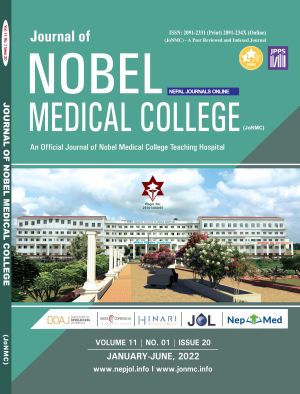Outcome of Soft Tissue Coverage in Open Tibia Fractures with Non-Microvascular Flap at a Tertiary Care Hospital
DOI:
https://doi.org/10.3126/jonmc.v11i1.45731Keywords:
Open fracture, Debridement, Soft tissue injuriesAbstract
Background: Open tibia fractures are high energy injuries often associated with large soft defects, extensive soft tissue stripping and contamination requiring multiple debridement procedures. Collective ortho-plastic approach helps us achieve proper debridement, adequate fixation and early soft tissue coverage. Due to fairly high incidence of failure, steep learning curve, time consuming procedure and the cost of treatment for those tedious free flaps, non-microvascular flaps are being preferred to cover the soft tissue defects or exposed hardware in open tibia fractures.
Materials and Methods: A prospective study was carried out in 19 patients to assess the outcome of soft tissue coverage in open tibia fractures with non-microvascular flap. Out of these patients, 6 patients were treated with medial gastrocnemius flap, 5 patients with medial hemi-soleus, 5 patients with reverse sural fasciocutaneous flap, and 3 patients with local rotational random flaps. Outcome measures included bony union, deep surgical infection and flap failure.
Results: 84% patients were male whereas 16% patients were female. Road traffic accident was the major cause of the defect among the patients (74%). Complications in the form of deep infection (10%), non-union (21%), delayed union (10%) and marginal flap necrosis (21%) were observed.
Conclusion: In our study, early soft tissue coverage with appropriate non-microvascular flaps in management of severe open fractures of tibia was associated with more favourable outcomes.
Downloads
Downloads
Published
How to Cite
Issue
Section
License

This work is licensed under a Creative Commons Attribution 4.0 International License.
JoNMC applies the Creative Commons Attribution (CC BY) license to works we publish. Under this license, authors retain ownership of the copyright for their content, but they allow anyone to download, reuse, reprint, modify, distribute and/or copy the content as long as the original authors and source are cited.




